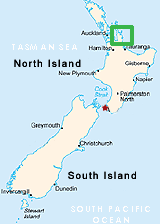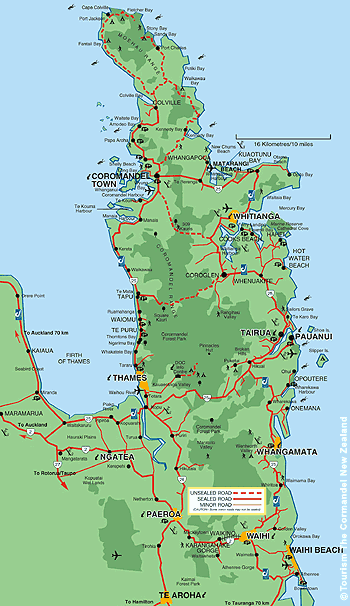


All our travel articles regarding the Coromandel region can be found here: The Coromandel Region
Overview The Coromandel Region
– Take a few days to enjoy this exceptional part of New Zealand – it is too good to miss.
About 400 km of impressive and unspoiled coastline with some of the best white sand beaches of the country, quaint historic towns as well as rugged volcanic landscape with native rain forest which offers plenty of hiking and biking opportunities are some of the features that make The Coromandel region one of most popular regions among New Zealanders to spend their vacation.
Located about 90 minutes drive from Auckland along the spectacular Pacific Coast Highway and a similar distance to the cities of both Rotorua and Tauranga, The Coromandel is convenient to reach and will reward visitors with outstanding impressions.
Along with its natural beauty – misty rainforests and pristine beaches – it’s historical past is rich and colorful. Captain Cook visited the area in 1769 and observed the transit of the planet Mercury across the face of the sun hence the names of some of the region’s beaches and bays – Mercury Bay and Cook’s Beach.
In the nineteenth century the peninsula teemed with human activity associated with the exploitation of timber, gold and kauri gum. Eventually the kauri and the accessible gold were exhausted and the gum market destroyed. The Coromandel lapsed into an economic and social decline that was eventually halted by the gradual growth of farming, fishing, horticulture, and tourism. The land slowly “mended” and a new era of people moved into the area, one that valued the environment. Thirty four percent of the land on the peninsula is now administered by the Department of Conservation.
Many visitor attractions have been developed so that visitors can reflect on the region’s former days. The Coromandel’s history is captured in the many museums around the region. Guides are available to take visitors into the bush to view the remnants of the gold mining and logging era.
Walking, hiking, biking
The mountains are remnant of the Coromandel’s volcanic past and are largely covered in regenerating native bush recovering from the pioneering past. In the later part of the 1800’s gold was discovered in the Coromandel area – between 1862 and 1952 it has been reported that 16 million tones of ore were mined from Coromandel goldfields. Kauri logging was also a major industry in early pioneering days of the Coromandel and the hills filled with huge kauri tree all but disappeared off the peninsula. As a result of this past many of the walks in the area are steeped in gold mining and kauri logging history.
Art & Crafts
Many artists and craftspeople have made the Coromandel their home, inspired by the region’s idyllic setting. Visitors can follow an arts and crafts trail from one side of the peninsula to the other following the popular Pacific Coast Highway.
Enjoy Coromandel’s Beauty & Diversity
Other tourism operators have established themselves to take advantage of the clear waters and many kilometers of coastline and islands surrounding the Coromandel. Choose from the numerous water activities available – fishing, sailing, kayaking, snorkeling or swimming.
The Coromandel Peninsula, its towering bush-clad ranges and beautiful beaches defining the eastern side of the Hauraki Gulf, has long entranced people.
Once they went to log the kauri which clothed the ranges and to mine the gold within them. The name Coromandel derives from a sailing ship, the SS Coromandel, visiting the area in search of spars for the Royal British Navy.
Now they go to “get away from it all”, enjoying the beauties of coast, regenerating bush and wildlife, including the few fine stands of kauri untouched. The sixth largest kauri in the country, Tanenui, is growing at Manaia on the Peninsula. Signs of Coromandel’s logging and gold-mining past are still very evident in old mine shafts, disused railway lines and kauri dams.
Ancient pohutukawa trees, crimson-flowered at Christmas time, shade the coastal highway around the Peninsula. Cape Colville and Waikawau Bay Farm Parks allow visitors to experience New Zealand farm life in an idyllic setting. Coromandel Forest Park, with its spectacular skyline, covers the back-bone of the Peninsula, and is criss-crossed with tracks allowing trampers to experience both the wildlife and the history of the area.
Mt Moehau, rising to 892 meters, is the highest point and with the surrounding reserve, ranks internationally as an important ecological site. From Stony Bay and Fantail Bay the continuum of forest goes from coastal to sub-alpine. Control of possums, goats, mustelids, rodents and invasive weeds is a major focus of Department of Conservation work.
Off the tip of the Peninsula, 30 kilometers to the east, lies Cuvier Island. Its light, New Zealand’s most distant off-shore lighthouse, has been guiding ships entering the Hauraki Gulf since 1889. The 171 hectare island was named in 1827 by the French navigator Dumont D’Urville. Once two lighthouse keepers and their families lived there. But the light is now fully automated and the island an uninhabited nature reserve.
Data & Facts about Coromandel Region
Drive Times
Auckland to Thames: ca. 1:30 hrs if you take the highway SH2; 45 min. longer if you go through Clevedon to meet the Firth of Thames. Continue along the Seabird Coast to Miranda, then onward to Thames. The Pacific Coast Highway follows the coast road around the region, offering wonderful sights and views.
From Rotorua to Thames over the SH5, SH27 and SH26 to Paeroa to Thames or Waihi: 2:30 hrs.
Population
ca. 39.000
i-Sites
Visitor Centre Thames
The Visitor Center is located at: 206 Pollen St, Thames
Visitor Centre Coromandel Town
The Visitor Center is located at: 355 Kapanga Road, Coromandel Town
Visitor Centre Whitianga The Visitor Center is located at: 66 Albert Street, Whitianga
Visitor Centre Tairua The Visitor Center is located at: Main Road, Tairua
Visitor Centre Whangamata The Visitor Center is located at: Port Road, Whangamata
Visitor Centre Waihi The Visitor Center is located at: Seddon Street, Waihi
Visitor Centre Paeroa The Visitor Center is located at: 1 Belmont Rd, Paeroa

